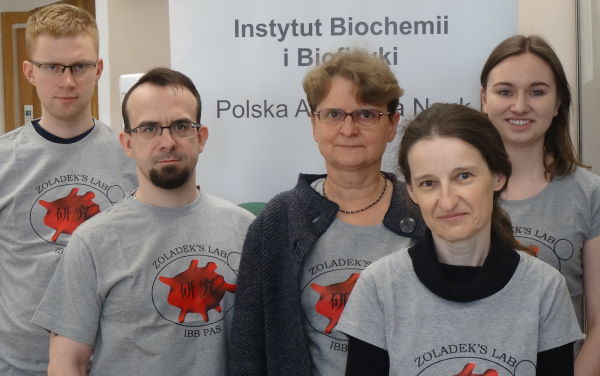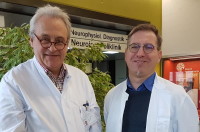Damian Kolakowski, Joanna Kaminska, Teresa Zoladek, Institute of Biochemistry and Biophysics Polish Academy of Sciences
The Binding of the APT1 Domains to Phosphoinositides Is Regulated by Metal Ions in Vitro
This article was published in Biochim Biophys Acta Biomembr. 2020;1862(9):183349. doi:10.1016/j.bbamem.2020.183349
Chorein is a protein of the Vps13 family, and defects in this protein cause the rare neurodegenerative disorder chorea-acanthocytosis (ChAc). Chorein is involved in the actin cytoskeleton organization, calcium ion flux, neuronal cell excitability, exocytosis and autophagy. The function of this protein is poorly understood, and obtaining this knowledge is a key to finding a cure for ChAc. Chorein, as well as the Vps13 protein from yeast, contains the APT1 domain. Our previous research has shown that the APT1 domain from yeast Vps13 (yAPT1v) binds phosphatidylinositol 3-phosphate (PI3P) in vitro. In this study, we showed that although the APT1 domain from chorein (hAPT1) binds to PI3P it could not functionally replace yAPT1v. The hAPT1 domain binds, in addition to PI3P, to phosphatidylinositol 5-phosphate (PI5P). The binding of hAPT1 to PI3P, unlike the binding of yAPT1v to PI3P, is regulated by the bivalent ions, calcium and magnesium. Regulation of PI3P binding via calcium is also observed for the APT1 domain of yeast autophagy protein Atg2. The substitution I2771R, found in chorein of patient suffering from ChAc, reduces the binding of the hAPT1 domain to PI3P and PI5P. These results suggest that the ability of APT1 domains to bind phosphoinositides is regulated differently in yeast and human protein and that this regulation is important for chorein function.

The photo shows the team, From the left, are Piotr Soczewka, Damian Kolakowski, Teresa Zoladek, Joanna Kaminska and Patrycja Waraszka. To read the full paper click here.

Gabriel Miltenberger-Miltenyi, MD, PhD
Department of Neurology, LMU University, Munich, under the supervision of Professor Dr. Adrian Danek
Search for critical VPS13A mutations in the Munich chorea- acanthocytosis (ChAc) patient cohort, including the revitalization of the chorein Western blot service and ChAc database
Main objectives of the project are: a. Revitalization of the chorein Western blot b. Revitalization of the NA database; c. Genetic analysis of the ChAc-responsible VPS13A gene in blood samples available at LMU.
Results - Revitalization of the chorein Western blot
As mentioned in my 1st Scientific report, I set up a collaboration with Prof. Bettina Schmid at the German Center for Neurodegenerative Diseases (DZNE, Munich) including Ms. Qing Wang, a Masters student through the Graduate School of Systemic Neurosciences, supervised through Profs Schmid, Danek and myself.
We re-vitalized the Western blot technique for the diagnosis of ChAc using two different antibodies linking to the two different endings (N-terminus and C-terminus) of the chorein protein. One antibody is that of the original description of Dobson-Stone (2004), the other antibody is a new commercial one. Together with this, we elaborated new laboratory protocols to the Westen blot technique.
This is the first attempt to compare the reliability and usability of various chorein antibodies in the Western blot diagnostics. The usage of two antibodies in parallel has following advantages:
1. It allows to carry out and thus confirm the routine diagnostic results with two independent protocols. The possibility of getting false positive result is therefore minimized.
2. It allows to follow up the effect of mutations in the VPS13A gene that (i) affect different regions of the chorein protein or/and (ii) do not lead to a complete loss of the chorein protein (thus to a complete loss of the band in Western blot).
Indeed, we managed to point out ChAc cases, where normal chorein band appeared using one single antibody, although disease-causing mutations in the VPS13A gene were detected afterwards (see also below).
We managed to analyse all 79 samples, that we received with the request for Western blotting since 2016 and that were pending. 9 samples showed uncertain results, these we will repeat.
Together with this, now we started to elaborate a new version of the clinical-laboratory reports on the Western blot results, that we will send to the physicians who submitted the samples. Parallel, Professor Danek contacts these physicians directly.
Furthermore, the new project with DZNE on the elaboration of a zebrafish model of ChAc (see my 1st Scientific report) has advanced. This project will serve as the Master thesis of Ms. Qing Wang.
Results - Revitalization of the NA database
Regarding sample storage of the ChAc patients, we continued with our collaboration with the Munich based genetic reference centre “Medical Genetics Center” (MGZ/Cryondo). (See also my 1st Scientific report.) The samples are stored in secured circumstances, with rapid access and the easy adoption of novel samples. (For note: all samples are anonymized, labelled solely with our internal code. All clinical information remained with Professor Dr. Danek within the LMU.) I am in permanent contact with the head of MGZ/Cryondo.
1. Based on this collaboration, MGZ/Cryondo was the partner, who extracted the erythrocyte membranes of the patients ́ blood samples for the Western blot analyses. I was organizing the performance of these extractions as keeping daily contact with the laboratory personal of MGZ/Cryondo, giving instructions, discussing protocols and results. I transported afterwards the extracted erythrocyte samples to DNZE.
2. For the better handling of patient data, I continued with the digitalization of the submitted clinical information of the patients keeping it in a protected data storage space of the LMU University. (See also my 1st Scientific report.)
3. As mentioned in my 1st Scientific report, I initiated the participation of Professor Dr. Adrian Danek, Dr. Antonio Velayos-Baeza and myself as curators at the international, open-access Leiden Open Variation Database (LOVD). In the meantime, we were nominated as curators, and together with Antonio Velayos-Baeza we are in permanent contact with the LOVD centre (Netherlands) to organize the best way to upload clinical and/or genetic data to this site. And we also received a positive feedback from our Swiss collaborators to be curators for the XK gene mutations.
Results - Genetic analysis of the ChAc-responsible VPS13A gene in blood samples available at LMU
As mentioned in my 1st Scientific report, for the genetic testing, I set up a collaboration with the genetic reference centre Institute of Human Genetics at the TU University/Helmholtz Center in Munich.
In the first analysis of patients with ChAc or ChAc-like clinical diagnosis, but with normal chorein band in Western blot (22 cases), we managed to detect pathogenic mutations in six patients. Thus, we managed to clear up six previously unsolved cases.
Of these, in four patients a core neuro¬acanthocytosis syndrome was diagnosed: in two patients each from mutations in the VPS13A gene (confirming the diagnosis of ChAc) and from mutations in the XK gene, associated with McLeod syndrome. Two patients showed mutations in genes associated with other types of movement disorders (KMT2B, GNAL).
Note: overall, we have currently observed seven cases with pathogenic VPS13A mutations in the presence of normal appearing chorein bands in Western blotting. These observations show that the chorein Western blot has - in some cases - a less than 100% sensitivity for the diagnosis of ChAc. Thus, they stress the need to follow up on patients with clinical features highly suggestive of ChAc even if chorein Western blot appeared normal. Studying these cases appears of greatest interest with respect to functional domains of the VPS13A gene.
Besides, we started to elaborate clinical-genetic reports for these patients that we are sending to their physicians. And, Professor Dr. Danek contacts these physicians directly.
Further started/achieved points, in which I am participating
1. We started a new collaboration with Dr. Kevin Peikert. This collaboration focuses on the lipid level alterations in patients with ChAc. I was invited to this collaboration based on my previous works in the field in Parkinson ́s disease (Parkinsonism Relat Disord. 2017) and Rheumatoid arthritis (Rheumatology. 2019).
2. Under the leadership of Professor Dr. Danek we managed to clarify the question about the diagnosis of two siblings, with the original clinical diagnosis of ChAc, from the UK. Previous genetic investigations of these patients detected only one single (i.e. heterozygous) variant with unknown significance in the VPS13A gene. We carried out now Western blot in one of the siblings, that showed normal chorein band. Based on our recent genetic analyses, we managed to discover pathogenic mutations in the PANK2 gene. The analyses of the parents of these siblings is still running.
3. With the support of Professor Dr. Danek, I was invited to a recent scientific report about Swedish ChAc patients: Phenotypic variability in chorea- acanthocytosis associated with novel VPS13A mutations. We carried out the Western blot analyses of these patients. The paper was accepted in Neurology: Genetics.
Two further projects, that I already mentioned in my 1st Scientific report are continuously on-going:
4. In collaboration with the LMU Department of Nuclear Medicine 2 MLS patients (from Munich) and 2 ChAc patients (from Dresden) were examined with the GE-180 tracer that binds to the mitochondrial TSPO protein which is regarded as an indicator of microglial activation in the brain. The pattern found in the 4 cases resembles earlier findings in Huntington ́s disease and might be useful as a biomarker for ongoing CNS processes in response to the impaired intracellular pathways in the NA syndromes of MLS and ChAc.
5. We set up a collaboration with Professor Lars Kaestner, from the Theoretical Medicine and Biosciences, Saarland University, Saarbruecken, Germany. Professor Kaestner is biophysicist and interested in the biophysical-biochemical analyses of erythrocytes in ChAc. He has come to Munich already twice to collect samples from our two local MLS patients and in a phone conference with him and Kevin Peikert we discussed the very promising pilot results, including those in the Dresden ChAc patients, that ought to be presented at the Barcelona meeting.
Next steps
The main objective is to continue with the initiated collaboration on a long-term duration. The very next steps include:
1. We will continue with the Western blot analyses of the patient samples, especially: a. finish with 9 cases, that did not show clear results in the first Western blot runs; b. compare the results gained using the two different chorein antibodies; c. carry out quantitative analyses of the chorein bands detected in the Western blot. This can serve for the better interpretation of the results in the ChAc diagnostics; furthermore, it can help to gain more information about the effects of the different VPS13A mutations on the chorein protein. This is also a unique investigation project, as such. For these analyses, we can use the equipment of DZNE. d. We will write clinical-laboratory reports for the analyzed cases.
2. Continue with the genetic analyses and reports. Contact physicians in charge.
3. Make awareness of the availability of the Western blot technique and of the genetic diagnostics at LMU in the whole international patient community.
4. Continue with the application as curators for the NIH-linked ClinVar/ClinGen mutation database for the VPS13A gene.
5. Elaborate scientific papers about our findings on the patients with normal chorein band and with pathogenic mutations in the VPS13A gene.
6. Continue with the implementation of the zebra fish model for ChAc.
Summary
Principally, the main objectives, regarding Points 1 to 3, that we set in February 2019, were achieved in time. In all laboratory analyses we used the newest methods. Additionally, we achieved several further points, as discussed above.
With all our results we continuously reach back to the patients and/or the physicians in charge, meaning that all our results support the ChAc (and NA) patient community. Therefore Point 3 in our Next Steps, has a special importance.
All these achieved points were only reachable with the generous support of the Advocacy. This financial support allows the continuation of the scientific works until August 30, 2020.
The long-term goals of Professor Dr. Danek and myself is the continuation of these diagnostic and research studies that gave us very promising results, until 2023, when our scientific knowledge, samples, protocols, etc. will be transferred to our colleagues in Rostock.